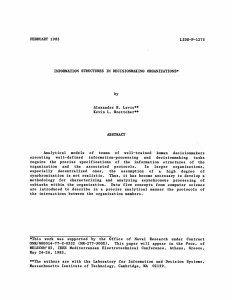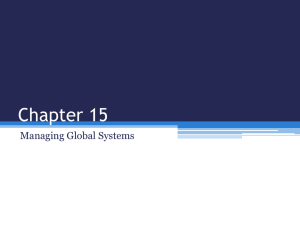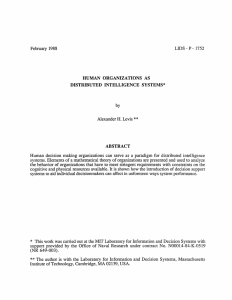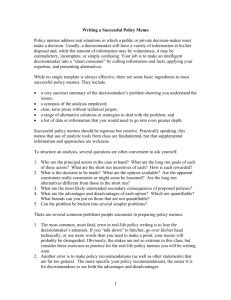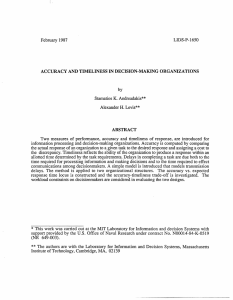MAY 1985 LIDS-P-1466 INFORMATION STORAGE AND ACCESS IN DECISIONMAKING ORGANIZATIONS* by
advertisement
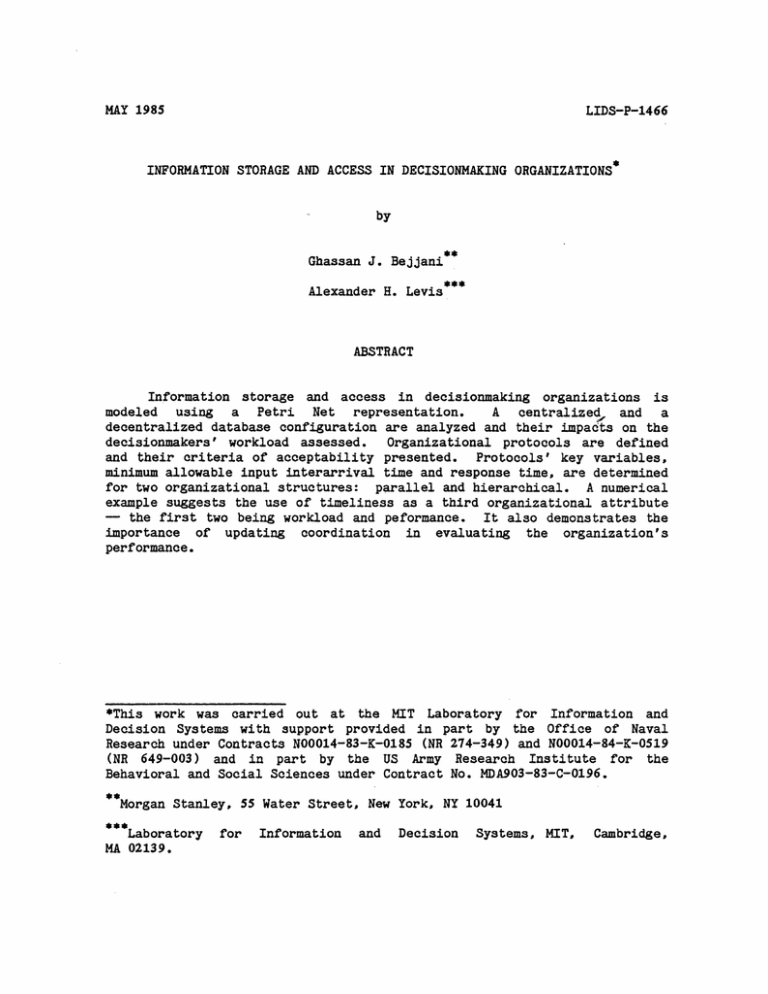
MAY 1985 LIDS-P-1466 INFORMATION STORAGE AND ACCESS IN DECISIONMAKING ORGANIZATIONS* by Ghassan J. Bejjani Alexander H. Levis ABSTRACT Information storage and access in decisionmaking organizations is modeled using a Petri Net representation. A centralizedr and a decentralized database configuration are analyzed and their impacts on the decisionmakers' workload assessed. Organizational protocols are defined and their criteria of acceptability presented. Protocols' key variables, minimum allowable input interarrival time and response time, are determined for two organizational structures: parallel and hierarchical. A numerical example suggests the use of timeliness as a third organizational attribute the first two being workload and peformance. It also demonstrates the importance of updating coordination in evaluating the organization's performance. *This work was carried out at the MIT Laboratory for Information and Decision Systems with support provided in part by the Office of Naval Research under Contracts N00014-83-K-0185 (NR 274-349) and N00014-84-K-0519 (NR 649-003) and in part by the US Army Research Institute for the Behavioral and Social Sciences under Contract No. MDA903-83-C-0196. Morgan Stanley, 55 Water Street, New York, NY 10041 Laboratory MA 02139. for Information and Decision Systems, MIT, Cambridge, 1. INTRODUCTION During the past decade, information theory has been applied to and analysis evaluation of developed First organizations. by the Shannon (Shannon and Weaver, 1949), information theory matured into a mathematical theory in its own right, and applied was human (see Sheridan decisionmaking the study of various It was then used as a basic tool communications systems (Gallager, 1968). for modeling to and 1974, Ferrel, and The Partition Law of Information (Conant, 1976) provided a Drenick, 1975). physical interpretation of the mathematical expressions derived by using the n-dimensional version of the theory. A two-stage information theoretic model introduced by Boettcher and Levis (1982). of the decisionmaker was Quantitative means for measuring the human decisionmakers' workload and the organization's performance were designed under a set of restrictive effort (Hall and Levis, 1984; assumptions. Chyen and Levis, 1985; Subsequent research Tomovic and Levis, 1984) was oriented towards relaxing some of those assumptions and resolving more complex issues related to a realistic use of the decisionmaking model. This paper addresses the issue that decisionmakers are not memoryless (an assumption in the original model) and that information storage and service in most modern organizations. acccess devices are actually put to The study of databases in acyclical organizations is approched along two directions: (a) computation of modified activity terms that represent the decisionmaker's workload and (b) consideration of time and delays in the normal functioning of an organization. separately but are The two directions are developed brought together in the illustrative example of the last section. Figure 1 shows the Petri Net representation (Tabak and Levis, 1984) of the two-stage model of the nth member of an organization. His input xn is a component of a single vector source distributed by a set of partitioning matrices among decisionmaker all the decisionmakers (Stabile and Levis, 1984). The processes this input in the situation assessment (SAn) stage 2 DM" unmin on no i7r Petri Net Representation of the nth Decisionmaker of the Figure 1. Organization to determine or select a particular value of the variable zn that denotes the situation. He may communicate his assessment of the situation to other members (zn °) and he may receive their assessments in return (zon). This supplementary information may be used to modify his assessment, i.e., it may lead to a different value of zn denoted by zn . Possible alternatives of action are evaluated in the response selection (RSn) stage. The outcome of this process is the selection of a local action or decision yn that may be communicated to other team members or may form all organization's response. or part of the A command input from other decisionmakers, v°n, may affect the selection process. The situation i=1,...,U). assessment stage consists of U algorithms (fin, The value taken by the variable un determines the algorithm to 3 distribution p(un). be used, and is chosen according to the probability Similarly, the choice of an algorithm in the RS stage is determined by the variable Vn , with probability distribution p(vnlzn'). As a response to the handling memory and information need for in today's organizations, the concept of Decision Aids first appeared a litle These devices are evolving into well-integrated more than a decade ago. Decision Support Systems (DSS) (Keen, 1981). three main parts information terminal) Decision Support System. program, and of a management The database is one of the (Sprague, 1980; a Sprague and machine-user Carlson, address the database and decisionmaker/machine and their impact on the other two are interface 1982). an (computer This paper will interface issues from an The database's information theoretic point of view. procedures, The storage and access decisionmaker's workload and performance levels, will be described. 2. THE GENERAL DATABASE MODEL The database model developed in this paper conforms to the traditional definition of an information storage device: from an external source, it stores it can receive information it adequately, and it delivers information, or part of it, whenever accessed by its users. model adopted here consists of two stages (see Fig. 2). this The Petri Net The first stage, transition C, receives an input from the decisionmaker who requests access to the data. This input represents the situation in which the user is. Transition C determines then the nature of the information needed to cope with that situation, and sends a query to the next stage, D. Transition D performs the actual search, and delivers the data to the decisionmaker at a predetermined stage of his internal decisionmaking process. DB Figure 2. c Petri Net Representation of the General Database Model 4 Databases can be used in Decentralized either configuration. a centralized are databases or defined a decentralized as here individual storage units, accessed exclusively by one decisionmaker, and holding and It was delivering information relevant to this decisionmaker's task only. proved (Bejjani, 1985) that the increase in activity due to a centralized However, there are important or decentralized configuration were similar. differences. First, the time associated with is much the query process shorter when the database is an individual one than when it is centralized. In effect, in the former case, no irrelevant information is to be scanned and then discarded, which happens in the latter case, answer to its centralized database It updating. stimuli decisionmakers can structure be with more is is updated equally timely. in that one recent However, an allows for it operation, information, the system's and of advantage more convenient providing whereas a all the decentralized databases require a much greater updating effort to obtain the same result. This paper will develop information theoretic aspects of the centralized databases and discuss the decentralized case briefly (for a comprehensive comparison of the two configurations, the reader is referred to Bejjani, 1985). 2.1 Centralized Databases A centralized database is a database shared by all organization. terminals It is allow the physically located decisionmakers to in one access place, members and of the individual it independently. In the Petri Net representation, a centralized database is modeled as one unit, comprising several transition Cltransition D sequences. databases, one for the SA stage, called DBSA, DBRS. Cn in DBSA The inputs to transition There are two such and one for the RS stage, are the inputs to the nth decisionmaker, xn , and the variable un indicating the SA algorithm he is about to use (see Fig. 3). Transition Cn emits then a message towards transition Dn that carries a query for the information needed for DM n to process xn through the selected SA algorithm. Dn in turn delivers the requested data, dnA, to the decisionmaker, who receives it as an input to the algorithm he is using. applied to the RS stage. The usage of DBRS follows a similar rationale DMn _ un n B Mn - n v" : , : n '--- n Vh dn : : onn E:RS _ I · BSA In y" . .A C . dD 0D dRS * 0 : : Figure 3. Petri Net Representation of DMn Using Centralized Databases The use of databases has a significant impact on the decisionmaker's workload, as can be seen in the following development. Activity rate terms are derived by applying the Partition Law of Information Rates 1976) to the decisionmaking model used For here. a more (Conant, complete description of the calculations, the reader is referred to Bejjani (1985). The modifications to the basic model are due to the presence of two supplementary variables, dnA and dnS, and to their relationship with the existing structure. For simplicity, the superscript n will be omitted in the following equations whenever confusion may not arise. 6 Throughput Rate: F - Ft T(xdSAz on onxno :uz vdRS y) ,zv pZpVpy _no (1) Blockage Rate: (2) Fb = H(x,dsA,z°nv°ndRs) -Ft Noise Rate: F n LH_(v) z = H(u) + (3) Coordination Rate: U ( Fc = H(pi)) + H(z) (p(x,ds)) + L c SA ~SA i=! + A (p(z,zon)) + -B (p(,von)) V (g+j (P(idRs)) + Q + j=l +H(z) + H(E) U RS RS H(pj)) + R(y) n +) + H(Z,V) + T(xdsA:z on on ..... on vol) v n T_(x,dsAzn :dRs) (4) pj = p(v=j) (5) + TZ, (x,dsAz°n v where Pi = p(u=i) ; 7 H(p) = plogzp + (1-p)logz(1-p) (6) and ai is the number of variables of the algorithm i that are reinitialized at each iteration. The symbol rSA designates the mean interarrival time of the input to the SA stage. the RS stage. equations, if The the mean sRS has an equivalent meaning with respect to input interarrival interarrival source (Hall, 1982). time time can is not constant, The functions gic , cU+j be used in the by regulating the gA and gB are the individual coordination rate functions of the SA, A, B, and RS algorithms, and are of the following form: ai u <wgo (W ) ( u wl (7) j=1 The terms H(z), H(Z), H(R,V) in (4) can be interpreted to represent the direct coordination rate between subsystems, through the fact that one subsystem's output is between the subsystems Tz(x,dsA:zon) another's input. is accounted represents the However, indirect coordination for by the transmission rate terms. coordination relationship between x and dSA, and zOn . rate that is due to the Indeed, if the inputs to DMn and those to the rest of the organization (RO) are related, or if dnA and dmA, m A n, are not totally independent, due to the structure ofthe storage or the updating process in the centralized database, then zon can bring to SA information about the inputs to the system that is not contained in z. Similar interpretations hold for the other two transmission rate terms. The term TZ,v(x,zon,dsAv°n:dRs) raises the question of the relationship between dSA and dRS, i.e., whether the situation assessment database (DBSA) and the response selection one (DBRS) are related. 2.2 Decentralized Databases A decentralized database structure is shown in Figure 4. The only difference with respect to Figure 3 is the presence of only one transition Cn/transition Dn sequence per database, which models the exclusive use of 8 DMn Uzn nz n yn 71IR Petri Net Representation of DMn Using Decentralized Databases Figure 4. each database by a single decisionmaker. Apart from that, decentralized databases are assumed to function in exactly the same manner as centralized ones. 2.3 Fixed Databases and the Memoryless Model The results in section 2.1 were derived assuming the data dSA and dRS to be variable quantities. However, it might very well be the case that dSA and dRS are fixed, either because the databases are never updated or because the values taken by dSA and dRS remain valid during a very long time, compared to the mean input interarrival time. In this simple case, the database's direct contribution to the decisionmaker's activity rate is null, and the expressions developed above become similar to those derived in the basic memoryless decisionmaker case. eliminating the variables dSA and dRS and 9 They are derived by simply the input variables to the databases from the equations, which shows that the reduction from the database-equipped model to the memoryless one is consistent. 3. PROTOCOLS AND THEIR APPLICATION TO ORGANIZATIONAL STRUCTURES 3.1 Definition of Protocols and Determination of Their Key Variables elementary tasks have as between of the chronological order in which the description A protocol is to two or more be of performed within one decisionmaker as well them. Determination of procotols is a fundamental design problem for organizations in general, and of updatable database-equipped operations ones for each in particular. decisionmaker Indeed, are not clearly if the sequences defined, and if of the updating tempo of the database does not take these sequences into account, chaos can result. In brief, the situation could arise where different decisionmakers would be accessing different databases at different times, with different levels of accuracy and relevance of the data, in order to process the same input. Since the Petri Net representation (Tabak and Levis, 1984) clearly illustrates the organization's protocol as defined above and since a key notion in the definition of a protocol is the amount of time involved at each step of the decisionmaking process, an acceptable protocol for a given organization will consist of its Petri Net representation supplemented with the allocation of a processing time to each transition. The processing time in fact represents the maximum allowable duration of a transition for the organization to function in an orderly fashion, following its operating protocol. Assumptions: In devising an acceptable protocol for the kind organizations dealt with here, the following assumptions are made: (1) - the source emits the input X with a constant interarrival time (2) - the various transitions have constant processing times. (3) - communication between transitions is instantaneous. 10 of (4) - any transition can process an incoming input as soon as it has finished processing the previous one, and no sooner. (5) - no queueing is allowed at any stage of the process. Assumptions (1) and (2) are a corollary of the broader assumptions that the whole system operates in Assumption (3) states in steady state. fact that all the decisionmaking occurs within the transitions, and that no processing time is allocated to places. 'pipe-line effect' into words; this (4) is putting the Assumption the information flow assures that Assumption (5) is a prerequisite to the through the system is continuous. study of information application of Petri Net theory to the theoretic in effect, when queueing takes place, two or more decisionmaking models: Since transitions do not different tokens can coexist in the same place. have any means of recognizing priorities in choosing one token as an input out of the same place, the queue cannot be managed, and the organization's protocol is transgressed. (For a relaxation of this assumption, see Jin, 1985). Under assumptions (1) to (5), two necessary conditions Proposition: for an organization's protocol to be acceptable are: every transition in the system must have a processing time smaller than or equal to the mean input interarrival time. - the total amount of time spent by a token in one place cannot exceed the mean input interarrival time. necessary Both provide conditions symmetric a tool. analytical Indeed, if the processing times of the transitions in the system are fixed, time for the organization then the minimum admissible input interarrival can be determined: it is equal to the greater of two quantities: maximum time processing and organization, Determining this the maximum minimum on the Petri time any token present interarrival time is net diagram spends a very in of any useful the that place. way of comparing the effectiveness of different organizational structures in a given context. The second necessary condition applies in cases of 11 organizational interactions where one decisionmaker sends some information to another and cannot proceed before receiving a message the Thus, back. proposition provides a way of determining the upper limit of the response time of this decisionmaker, other being else everything This fixed. will be made clearer in the next section. As a last comment, one should realize that the use of the proposition is not restricted to decisionmaking organizations. are relevant to any information acyclical In fact, its arguments processing structure where Assumptions (1) to (5) are satisfied. 3.2 Construction of Protocols for the Centralized Case In this section, the proposition will be used to develop protocols for database configuration. two particular organizations using a centralized The basic quantity for each organization is a, the processing time of any SA or RS It transition. is assumed to be identical for all such transitions in both organizations, and it will be the unit used for all quantities computed here. Furthermore, v is assumed to be greater than the processing time of other types of transitions, on the grounds decisionmaking takes place in SA and RS transitions The database's response time is that more than in the others. assumed to be v as well. Parallel Organizational Structure In a parallel organizational structure, decisionmakers are linked by they do not formally issue commands to somewhat symmetrical relationships: each other, and they can share information at all stages according to preestablished operating The procedures. parallel structure considered in this work is a three-person organization, (Fig. 5) called 'Organization P" from here on. DM1 and DM 3 use only one SA algorithm and two RS algorithms each, and DMs has the choice between two SA algorithms, whose output can be processed by only one RS algorithm. the model, due to The command input von is absent from the non-hierarchical structure; the decisionmakers however share information about their situation assessments. 12 do Organization P uses databases, two centralized DBSA and DBRS; acceptable protocol for this organization has been derived and is (RT), the time I, and the organization's total response time it allows, between the arrival of fi and input the corresponding response, which is equal to the generation C' a rh z\ A D 13 X2 of 19v/3. Al3 z 2 7/' given in Its main characteristics are the minimum interarrival time (IT) Figure 5. interval An ' O' ~r/3dA -2r/3 rj3 21 r/3 [DMBRS 12T/3 f I ()d3 | f3r/3 2 r/3 lSA / M3 3 23 13 hiZ Hierarchical Organization Structure A hierarchical organizational structure allows decisionmakers to have an influence on each other's response selection. represented by a command input, von. This influence can be The hierarchical structure analyzed here is a three-person organization, known as organization H, equipped with centralized databases as shown in Figure 6. flf~ B' ~~Z -- 12/3 --- 2 C2 2 D DBRS 7r DBSA 3 /3 "/3d`S' DM X3 T~j dr A2 2 -1C Y r3 r/3.2,/3 , -/33 32 ( Z jt t DM 3 Figure 6. Protocol of Organization H Using Centralized Databases 14 Y3 Organization H consists of two decisionmakers who actually contribute to its output, DML and DM', and one coordinating decisionmaker, DM2, who analyzes DM1 's and DM2's situation assessments in order to issue a command to them that carries his instructions about the way the organization's response should be DM1 constructed. is not in contact with the environment, therefore he does not need an SA stage, neither do DM2 and DM3 need an information fusion transition, A. The three decisionmakers in organization H have each two RS algorithms. One acceptable protocol for organization H is that represented in The minimum interarrival time, 11v/3, is much greater than for Figure 6. organization P. This is due to the relationship between transition fx and DM , where information the coming out of fx has to be processed by all DM2's transitions before transition B x can be fired and the last token leaves the place zL. Application of the argument symmetric of the proposition's necessary conditions determined the mean interarrival time The organization's response time is calculated quite simply in as 11i/3. this case, by adding all processing times along the path followed by the original input and is 8,. For more complex organizations, the System Array approach is preferable for computing time delays (Tabak and Levis, 1984; Jin, 1985). 3.3 Construction of Protocols for Decentralized Case It was pointed out in section 2.2 that the only salient differences between a centralized and a decentralized structure as defined here pertain to transition D's processing time and the establishment of satisfactory updating. In this section, transition D is assumed to require a total time of v/3, which is half what was needed in the centralized configuration. Again, this number depends greatly on the nature of the organization's decision support system. Acceptable protocols for organizations P and H with databases are given in Figures 7 and 8, respectively. decentralized The minimun inter- arrival time IT and the response time RT for each organization are r and 15 12=/3 for the parallel one and 10t/3 and 7v for the hierarchical one. The reduction in the IT and RT, when compared to the centralized cases, is due entirely to the shorter response time of the database. DBSA1 DBRS I D ' x DBSA 2 X2 I C X DM2 2 gX3 2o ]t Alhi DBRS 2 D2 2 SA3 r73 S M Md~ 1 1 Z ) z22 Z1 , c r/R 02 do r3 S WE~k fZ Y Ez23 zz3 - hx f3 16 DM3 r/3 0MSA 3 SA -z3 r/ _ rS3 DSRS3 h3 Figure 7. Protocol of Organization P Using Decentralized Databases 16 32r/3 f r L -/S A2 3 S t~ h~A DBRS2 2- 21 DBRSL - DM3 Figure 8. Protocol of Organization H Using Decentralized Databases 3.4 Remarks Each protocol in the previous sections has been derived under some very specific conditions, in order to make different organizations and These different database structures comparable along the same criteria. results are contingent upon using similar transition processing times for both organizational structures. 17 17 2r! The minimum allowable input interarrival time is much greater for a hierarchical organization than for a parallel one. This follows from the more complex sequences of tasks that have to be performed in a hierarchical organization before a new input can be handled. The total response time is also greater for organization H than for organization P, and the difference is due again to the increased complexity. The second observation is that, whatever the organization, a decentralized database structure leads to improved performance with respect to time. In organization P, the decentralized structure leads to an 11% improvement in the response time over the corresponding centralized one, while in organization H its leads to improvements in both IT and RT of 9% and 13% respectively. These results are due to the basic premise that decentralized databases takes less time to perform the data query process than centralized ones do. (The numerical results of the above paragraphs are summarized in Table 1). TABLE 1. TIME CHARACTERISTICS OF ORGANIZATIONS P AND H Centralized DB Decentralized DB IT(P) I IT(H) 11-/3 10c/3 RT(P) 19-13 17'c/3 RT(H) 8- 7- IT = Minimum Allowable Interarrival Time; RT = Response Time 18 two 4. AN ILLUSTRATIVE EXAMPLE 4.1 In Description of the Organizations Used this section, tactical organizations, one parallel and one hierarchical, are used to address the issues that arise in the qualitative evaluation of organizations, the problems raised by a lack of coordination between several individual databases, and the trade-off between performance and timeliness. (The example is developed in its entirety in Bejjani, 1985). The first organization is the parallel one (Organization P) in Figure 5. It consists of three naval battle groups defending a maritime front. The first group, DM 1, center, and DM signals planes). holds one extremity of the the other end. emitted by front, DM2 holds the The inputs received by the organization are unidentified platforms (submarines, surface ships, The different decisionmakers' tasks are to attempt to identify the source of these signals (enemy or friends) in the SA stage, and to select the appropriate response (fire, request identification, or take all measures required to face an attack) in the RS stage. The SA database provides information, obtained from intelligence sources, that describes the codes the enemy could use when emitting the kind of signals received by organization P. This information will compared to the actual input to determine the latter's identity. be The RS database, DBRS, informs the decisionmakers about the level of alert present in their area at each iteration. The second organization is the hierarchical one (Organization H) shown in Figure 6. 1 DM and DM response. received 3 The context is the same as for organization P, but here only actually receive any external signals or select an active DM2 is a coordinator who, based upon the situation assessments from DM1 and DM3 , gives instructions about should be selected by either of them. is the one defined for organization P. 19 what RS algorithm The organization's overall mission 4.2 Results A primary feature of the example is its numerical simplicity: all the variables of the system are determined using binary logic based comparison of quantities; there are no actual computations. on the Detailed definition of the variables and the algorithms for the case of a single decisionmaker has already been presented (Boettcher, 1981). The basic step in the computation of the performance-workload pair (J,G) is determining the pure 1983). strategies In the present cases at in hand, the organization (Levis each DM pure has two and Boettcher, strategies, each obtained by the exclusive use of one algorithm (no decisionmaker here has, in any stage, more than two algorithms from which to choose). rates are a better measure of the decisionmakers' workload Activity than absolute activity, because of the time constraints present in real-world situations. The following equation applies here: Fi= i= i = 1,2,3 for either organization. (8) The performance measure J is the expected value of the cost the organization incurs when it does not produce the correct response for a given strategy and the input. The corresponding (J, G1 , 5G,53) space. workloads Gi determined by each pure performance level J are plotted in the Then, the performance-workload (P-w) locus for each DM is constructed where all possible mixed strategies are considered as linear combinations of the pure ones. The graphs thus obtained are the projections of the overall (P-W) locus of the organization on each of three planes: (G3 ,J). (G',J), G1 ,J), 1 Because the input is perfectly symmetric, 3 as well as DM 's and DM 's roles in each organization, only the projections for DM1 and DM' are shown. The use illustrating of activity very clearly (Figs. 9 and 10). H; rates in this the tradeoff instance between has the timeliness effect and of workload The performance of organization P is better than that of the performance index for P takes values between 0 and 0.9 for P but 20 between 1.2 and 4.5 for H. However, the workload of the members of P is much higher than that of H, namely, it varies between 8.1 bits/sec and 11.6 for P, while it is only 1.2 and 2.7 for H. Measuring workload in terms of activity rates gives organization H a significant advantage as keeping the decisionmakers' workload below a given maximum rationality constraint) is concerned. far as (the bounded However, another tradeoff appears here that involves the notion of timeliness. In effect, since in this example workload is a decreasing function of the mean interarrival time, Eq. (8), low workload levels are obtained by allowing a high IT, which penalizes the organization in terms of its timeliness. Thus, workload is reduced in H, but timeliness is sacrificed. Another consideration of interest is the effect of poor updating coordination on the organization's performance when decentralized databases are used (e.g., Figures 7 and 8). The impact of two different updating sequences on performance is reflected on the scheme, DM1 's and DM''s RS databases are assumed to be updated, at s + 0, in coordination with the input arrival. at New x + x, (P-W) loci. In the first DMX's DBRS, however, is updated with a delay of v over the input to which the data correspond. performance levels for each pure organization strategy were derived and a performance-workload locus was drawn (see Fig. 11(a)). The main effects are the upward movement of the original locus, and a degradation in performance: the range of J is from the perfectly coordinated (or 0.35 to 1.0 as opposed to 0 to 0.9 for the centralized) database case; this represents a drop of 29% in the average performance of the organization. A second scheme exhibits a less coordinated updating sequence: is updated at v + O, DBRS' at v + x, and DBRS 3 at s + 2v. DBRS1 DMx and DM3 both now have a greater propensity to make the wrong decision, and the resulting (P-W) locus is presented in Fig. 11(b). The best performance (lowest J) is now 0.8, which is very close to what the worst performance was in the coordinated case, and the worst performance level is 1.2. The range of possible performance levels has shrunk further, and the drop in average performance with respect to the original case is 68%. 21 J 4.5 4 3.5 3 2.5 2 1.5 DM 1 0.5d' 0 4 I 4.5 5 I I 5.5 6 I I 6.5 7 I I 7.5 8 I 8.5 I- 9 9.5 lO 10.5 t1 11.5G1 J 4.5 4 3.5 3 2.5 2 1.5 DM 2 0.5 4 4.5 5 5.5 Figure 9. 6 6.5 7 7.5 8 8.5 9 9.5 10 10.5 (P-W) Loci for P Using Activity Rates 22 11 11.5 J 4.5 4 3.5 3 _ DM 1 2.5 2 1.5 0.5 _ 0 i I ! 0.5 1 I t 1.5 I, , I 2 2.5 3 I 3.5 4 4.5 '5 I I 5.5 6 J i 4.5 4 3.5 3 DM 2 2.5 2 1.5 0.5 0 0.5 1 Figure 10. 1.5 2 2.5 3 3.5 4 4.5 5 5.5 6 (P-W) Loci for H Using Activity Rates 23 6.5 d 4.5 43.5 3 2.5 2 1.5 0.5 0'4 4.5 5 5.5 6 6.5 7 7.5 8 8.5 9 9.5 10 10.5 11 11.5 6.5 7 7.5 8 8.5 9 9.5 10 11 II.5 JG 4.5 4: 3.5 3 2.5 2_ 1.5 _ I 0.5 0 4 4.5 Figure 11. 5 5.5 6 (P-W) Loci for DM1 in 24 10.5 P with Uncoordinated Databases G Let the transition processing time be equal to v seconds. will be v seconds as well, and IT(H) 11/3 depending on the database configuration). seconds Then IT(P) (or 10/3 sec., In any event, IT(H) is much greater than IT(P) and may handicap organization H if it has to respond to threats arriving at a high rate. As an example, consider a wave of enemy planes attacking the battlegroup: processing every input through If no defense can be initiated without the SA stage, then the anti-aircraft batteries cannot shoot at a rate higher than one missile every 3.6v sec. If a new threat arrives once every v seconds, then P is an adequate structure, while H is far from being one. An additional disadvantage of organization H appears when response times are taken into account: the battlegroup will need 8S seconds to fire on a threat after it is detected; this might be too long if the threat is very close to the battlegroup when its presence is detected. When the platforms that the organization has to deal with are slower units, like submarines disadvantage is less or surface ships, organization H's timeliness critical, because of the longer time available for constructing an adequate response and because of the smaller threat arrival rate. In fact, the latter can be so small as to make any difference between IT(P) and IT(H) seem irrelevant. Since the organizations designed in this example have to deal with both slow and fast threats, one has to consider the relative probability of being attacked by fast or slow threats, and weigh it by the expected costs in each alternative during the evaluation of the two organizational structures. 5. CONCLUSION In this paper, the use of database networks was introduced into the organization, in decentralized. Information theoretic aspects of data storage devices were analyzed. two alternative configurations: centralized, and Time-related consideration were presented and used to create new criteria for the evaluation of the organization. the major theoretical results. 25 The example illustrated 6. REFERENCES 'Information Storage and Access in Decisionmaking Bejjani, G. J., Organizations,' M.S. Thesis, LIDS-TH-1434, Laboratory for Information and Decision Systems, MIT, Cambridge, MA, January 1985. Boettcher, K. L. "An Information Theoretic Model of the Decision Maker," M.S. Thesis, LIDS-TH-1096, Laboratory for Information and Decision Systems, MIT, Cambridge, MA, June 1981. Boettcher, K. L. and A. H. Levis, 'Modeling the Interacting Decisionmaker with Bounded Rationality,' IEEE Trans. on Systems, Man, and Cybernetics, Vol. SMC-12, No. 3, May/June 1982. Chyen, H. H-L, and A. H. Levis, 'Analysis of Preprocessors and Decision Aids in Organizations,' to be presented at the 2nd IFAC/IFIP/IFORS/IEA Conference on Analysis, Design, and Evaluation of Man-Machine Systems, Varese, Italy, September 10-12, 1985. Conant, R. C., 'Laws of Information Which Govern Systems,' IEEE Trans. on Systems, Man, and Cybernetics, Vol. SMC-6, No. 4, April 1976. Cothier, P. H., and A. H. Levis 'Assessment of Timeliness in Command and Control,' LIDS-P-1454, Laboratory for Information and Decision Systems, MIT, Cambridge, MA, April 1985. Drenick, R. F., 'Organization and Control,' Directions in Large Scale Systems, Y.C. Ho and S. K. Mitter, Eds., Plenum Press, New York, 1976. Gallager, R. G., Information Theory and Reliable Communication, John Wiley and Sons, Inc., New York, 1968. Hall, S. A., 'Information Theoretic Models of Storage and Memory,' MS Thesis, LIDS-TH-1232, Laboratory for Information and Decision Systems, MIT, Cambridge, MA, June 1982. Hall, S. A., and A. H. Levis, 'Information Theoretic Models of Memory in Human Decisionmaking Models,' Preprints of the 9th World Congress of IFAC, Vol. VI, Budapest, Hungary, July 2-6, 1984. Jin, V. 'Delays for Distributed Decisionmaking Organizations,' M.S. Thesis, LIDS-TH-1459, Laboratory for Information and Decision Systems, MIT, Cambridge, MA, May 1985. Keen, P. G. W., 'Value Analysis: Justifying Decision Support Systems,' MIS Quarterly, March 1981. Shannon, C. E. and W. Weaver, The Mathematical Theory of Communication, University of Illinois Press, 1949. 26 Sheridan, T. B., and W. R. Ferrell, Man-Machine Systems, MIT Press, 1974. Sprague, Jr., R. H., 'A Framework Quarterly, December 1980. for the Development of DSS,' MIS Sprague, Jr., R. H. and E. D. Carlson, Building Effective Decision Support Systems, Prentice-Hall, Englewood Cliffs, NJ, 1982. Stabile, D. A. and A. H. Levis, 'The Design of Information Structures: Basic Allocation Strategies for Organizations,' Large-Scale Systems, Vol. 6, 1984, pp. 123-132. Tabak, D. and A. H. Levis, 'Petri Net Representation of Decision Models," Proc. 7th MIT/ONR Workshop on C3 Systems, LIDS-R-1437, Laboratory for Information and Decision Systems, MIT, Cambridge, MA, December 1984. Tomovic, M. M., and A. H. Levis, 'On the Design of Organizational Structures for Command and Control,' Proc. 7th MIT/ONR Workshop on C s Systems, LIDS-R-1437, Laboratory for Information and Decision Systems, MIT, Cambridge, MA, December 1984. 27
